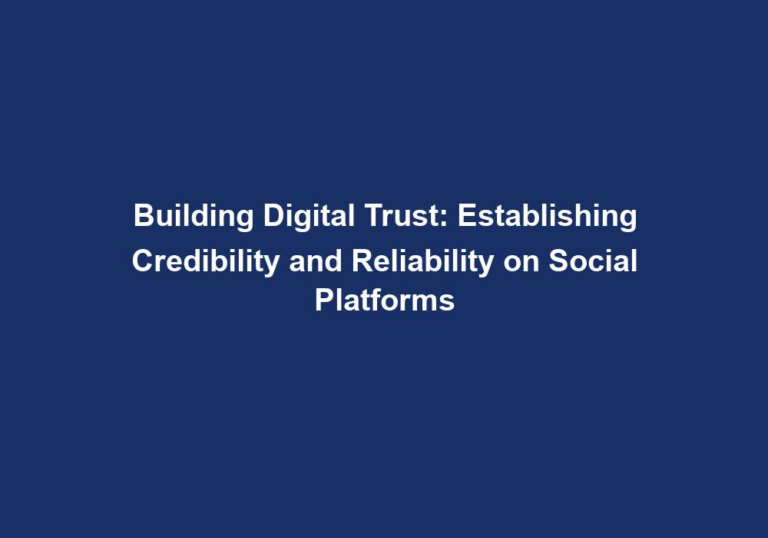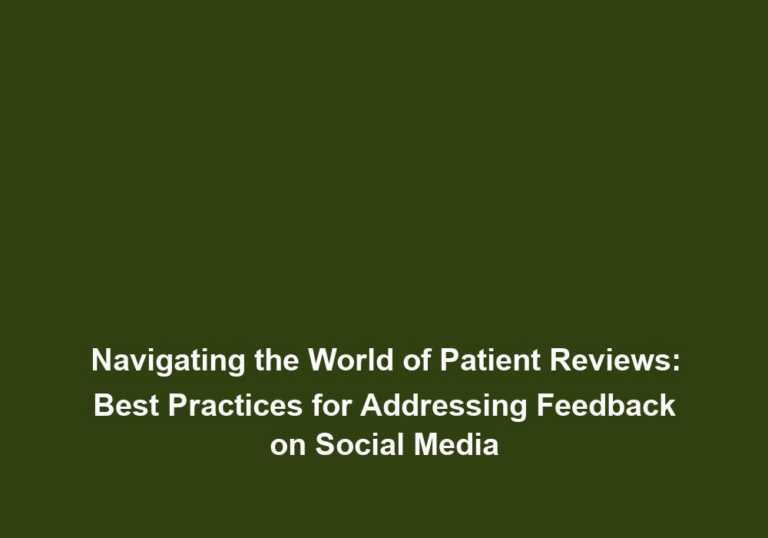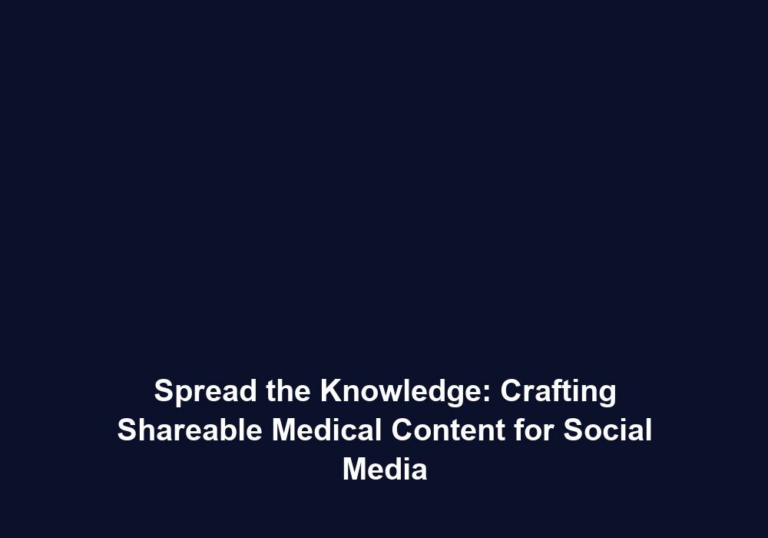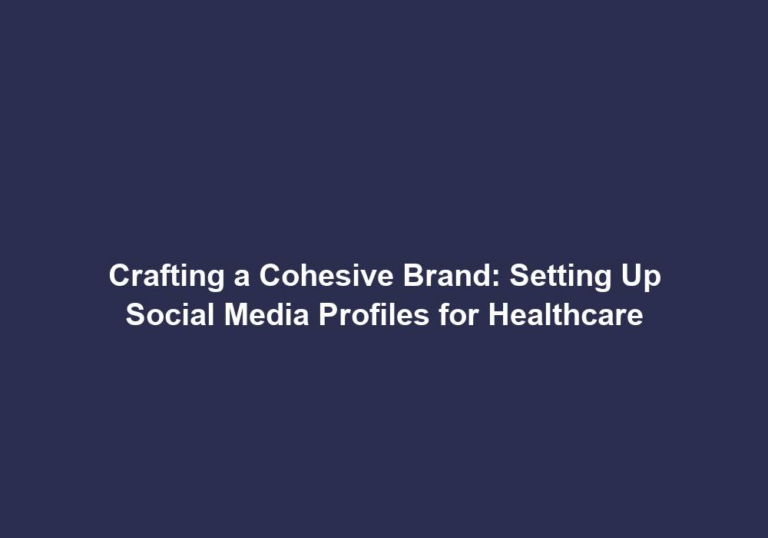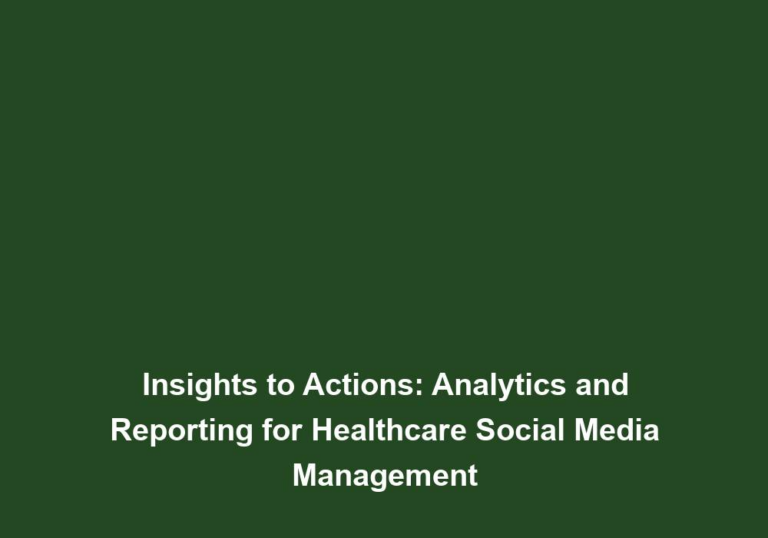Quantifying Social Success: The Power of Analytics and Reporting in Healthcare
In today’s digital age, social media has become an integral part of our lives. It has revolutionized the way we connect, communicate, and share information. This is particularly true in the healthcare industry, where social media platforms have emerged as powerful tools for engaging with patients, spreading awareness, and building strong online communities. However, in order to make the most of social media initiatives, it is crucial to measure and analyze the impact of these efforts. This is where analytics and reporting come into play.
Understanding the Significance of Analytics in Healthcare
Analytics refers to the process of collecting, measuring, and analyzing data to gain insights and make informed decisions. In the context of social media, analytics allows healthcare organizations to track and quantify the impact of their social media campaigns, identify trends, and measure the effectiveness of their messaging.
- Gaining Insights into Audience Engagement
Analytics provide valuable insights into audience behavior, interests, and demographics. Through social media analytics tools, healthcare organizations can track engagement metrics such as likes, shares, and comments. This information helps in understanding which types of content resonate the most with the audience and guides the creation of future content.
- By analyzing the number of likes, shares, and comments on social media posts, healthcare organizations can gain insights into what content their audience finds most engaging. This information can be used to tailor future content to better meet the interests and needs of the audience.
- Social media analytics also provide demographic information about the audience, such as age, gender, and location. This data can help healthcare organizations understand their target audience better and develop targeted marketing strategies.
- Understanding audience behavior through analytics can also help healthcare organizations identify trends and patterns. For example, if a particular type of content consistently receives high engagement, it may indicate a topic of interest that can be further explored in future campaigns.
- Monitoring Brand Reputation
Social media platforms serve as a powerful channel for patients to share their experiences and opinions about healthcare providers and services. By monitoring social media conversations and sentiment analysis, healthcare organizations can assess their brand reputation and address any issues or concerns raised by patients in a timely manner.
- Social media analytics tools can help healthcare organizations monitor mentions and conversations related to their brand. By tracking keywords and hashtags, organizations can identify positive and negative sentiment surrounding their brand and address any issues promptly.
- Monitoring brand reputation on social media allows healthcare organizations to respond to patient feedback and concerns in real-time. This not only helps in resolving issues but also demonstrates a proactive approach to patient care and satisfaction.
- Analyzing sentiment analysis data can provide insights into the overall perception of the brand. By understanding how patients perceive their brand, healthcare organizations can make necessary improvements to enhance their reputation and build trust among their target audience.
- Tracking Conversion Rates
Analytics can help determine the impact of social media initiatives on patient acquisition and conversion rates. By tracking the number of website visits, appointment bookings, or inquiries generated through social media campaigns, organizations can assess the return on investment (ROI) and optimize their strategies accordingly.
- Social media analytics tools allow healthcare organizations to track the number of website visits generated from social media platforms. By analyzing this data, organizations can measure the effectiveness of their campaigns in driving traffic to their website.
- Tracking conversion rates involves monitoring the number of appointment bookings or inquiries made through social media channels. This data can provide insights into the success of social media campaigns in converting leads into actual patients.
- By analyzing conversion rates, healthcare organizations can identify which social media platforms or campaigns are most effective in driving patient acquisition. This information can guide future marketing strategies and resource allocation to optimize ROI.
Leveraging Reporting for Effective Decision Making
Reporting plays a crucial role in the success of social media initiatives in healthcare. It involves compiling and presenting data in a clear and concise manner, making it easier for stakeholders to understand the performance of social media campaigns and make data-driven decisions.
- Creating Meaningful Dashboards
Dashboards are an effective way to visualize social media metrics and present them in a user-friendly format. By creating dashboards that display key performance indicators (KPIs) such as engagement rates, reach, and conversions, healthcare organizations can quickly assess the success of their social media efforts.
- Dashboards provide a comprehensive overview of social media metrics, allowing stakeholders to assess the performance of different campaigns and initiatives at a glance.
- Key performance indicators such as engagement rates, reach, and conversions can be displayed in a visually appealing manner, making it easier for stakeholders to understand the impact of social media efforts.
- By regularly updating and sharing dashboards with relevant stakeholders, healthcare organizations can foster transparency and collaboration, leading to more informed decision-making.
- Identifying Areas of Improvement
Through regular reporting, healthcare organizations can identify areas of improvement in their social media strategy. By analyzing metrics such as click-through rates, bounce rates, and time spent on page, organizations can gain insights into the effectiveness of their content and make necessary adjustments to optimize engagement.
- Click-through rates indicate the percentage of users who clicked on a link or call-to-action in a social media post. By analyzing click-through rates, healthcare organizations can determine the effectiveness of their content in driving user engagement and website traffic.
- Bounce rates represent the percentage of users who leave a website after viewing only one page. High bounce rates may indicate that the content is not resonating with the audience or that the website experience needs improvement.
- Time spent on page provides insights into how engaging and relevant the content is to the audience. By analyzing this metric, healthcare organizations can identify which types of content are most effective in capturing and holding the audience’s attention.
- Tracking Competitor Performance
Reporting allows healthcare organizations to benchmark their social media performance against industry competitors. By tracking competitor metrics such as follower growth, engagement rates, and content performance, organizations can gain valuable insights and stay ahead of the competition.
- By analyzing competitor metrics, healthcare organizations can identify industry trends and best practices that can inform their own social media strategies.
- Tracking competitor follower growth can provide insights into the effectiveness of their content and engagement strategies. Organizations can learn from successful competitors and adapt their own strategies to attract a larger audience.
- Analyzing competitor content performance can help healthcare organizations identify content gaps and opportunities. By understanding what type of content resonates with the audience, organizations can create more targeted and engaging content to drive better results.
Best Practices for Effective Analytics and Reporting in Healthcare
To make the most of analytics and reporting in healthcare social media initiatives, it is important to follow best practices:
- Define Measurable Goals
Before starting any social media campaign, it is crucial to define clear and measurable goals. Whether it’s increasing brand awareness, driving website traffic, or improving patient engagement, setting specific goals ensures that analytics and reporting efforts are aligned with the desired outcomes.
- Defining measurable goals allows healthcare organizations to track progress and evaluate the success of their social media initiatives.
- Goals should be specific, achievable, relevant, and time-bound (SMART). This ensures that the goals are realistic and provide a clear direction for analytics and reporting efforts.
- Select the Right Analytics Tools
There are numerous social media analytics tools available in the market. It is important to select the one that aligns with the organization’s needs and goals. From free tools like Google Analytics to comprehensive paid tools like Sprout Social or Hootsuite, healthcare organizations should choose a tool that provides relevant metrics and insights.
- Selecting the right analytics tool depends on the specific needs and goals of the healthcare organization. Free tools like Google Analytics can provide basic insights into website traffic and user behavior, while paid tools offer more advanced features and customization options.
- It is important to consider factors such as data accuracy, ease of use, integration capabilities, and cost when selecting an analytics tool.
- Regularly Monitor and Analyze Data
Analytics and reporting should not be a one-time activity. It is important to regularly monitor and analyze data to identify trends, track progress, and make data-driven decisions. By establishing a reporting cadence, healthcare organizations can stay informed about the performance of their social media initiatives and make necessary adjustments.
- Regular monitoring and analysis of data allow healthcare organizations to identify changes in audience behavior, track the success of campaigns, and make timely adjustments to optimize performance.
- Establishing a reporting cadence ensures that stakeholders are consistently informed about the performance of social media initiatives and can make informed decisions based on the data.
- Collaborate with Stakeholders
Effective analytics and reporting require collaboration between various stakeholders. Marketing teams, social media managers, and healthcare professionals should work together to define goals, track progress, and make informed decisions based on the insights gathered from analytics and reporting.
- Collaboration between stakeholders ensures that analytics and reporting efforts are aligned with the overall goals and objectives of the healthcare organization.
- By involving different perspectives and expertise, healthcare organizations can make more informed decisions and develop strategies that are more likely to succeed.
In conclusion, analytics and reporting play a crucial role in quantifying social success in the healthcare industry. By leveraging the power of analytics, healthcare organizations can gain valuable insights into audience engagement, monitor brand reputation, and track conversion rates. Reporting, on the other hand, enables organizations to present data in a meaningful way, identify areas of improvement, and make data-driven decisions. By following best practices and collaborating with stakeholders, healthcare organizations can harness the power of analytics and reporting to make their social media initiatives a resounding success.


